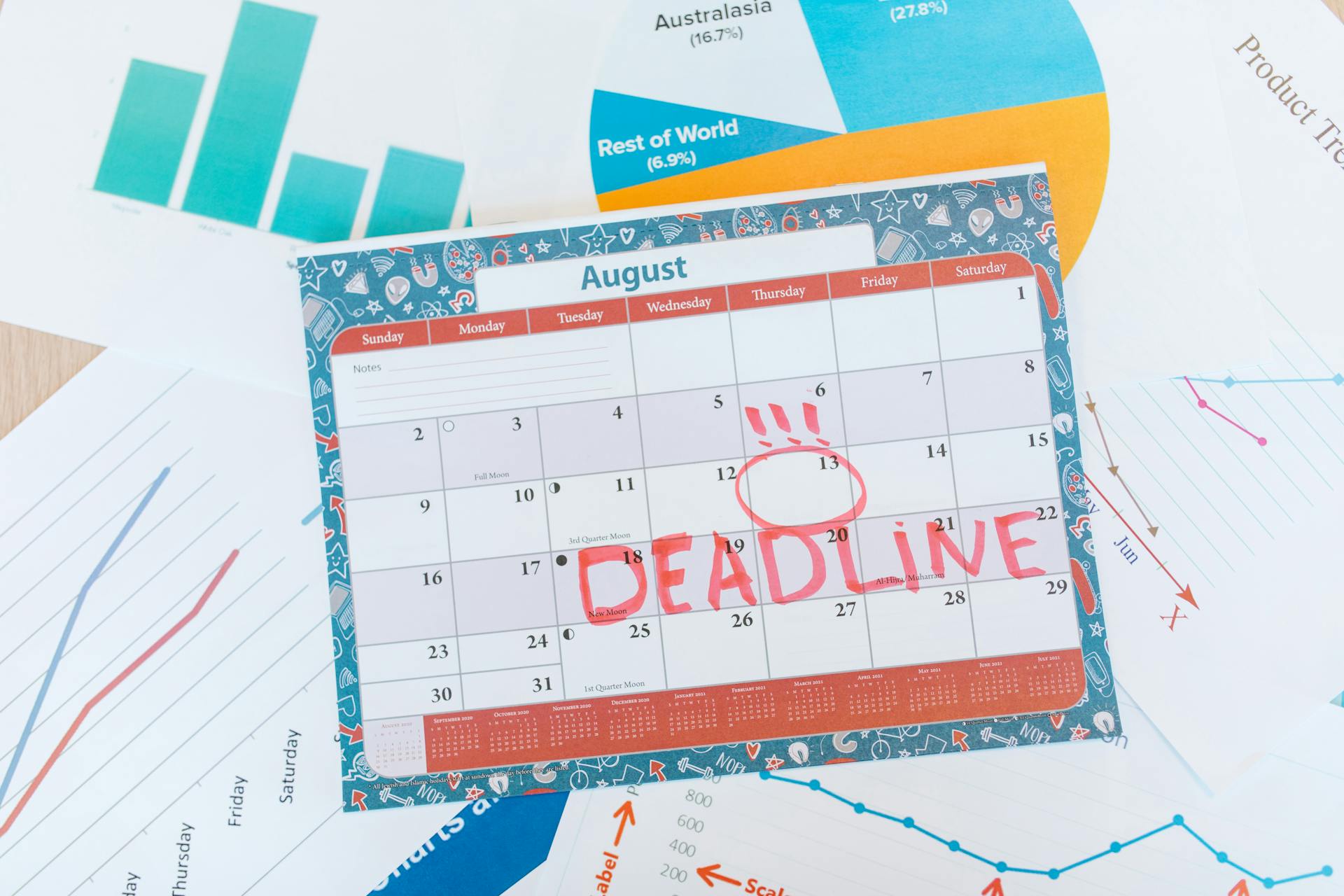
The RRSP contribution deadline is a crucial date to keep in mind, especially if you're looking to maximize your retirement savings. In Canada, the RRSP deadline is typically set for March 1st of each year.
To make the most of this deadline, it's essential to plan ahead. You can contribute up to 18% of your earned income to an RRSP, up to a maximum annual limit set by the government.
RRSP Contribution Basics
For 2022, the annual RRSP contribution limit is 18% of your earned income, up to a maximum of $29,210.
If you're part of an employer pension plan, your limit might be reduced by a pension adjustment or the benefits you earned in the previous year.
Unused contribution amounts from previous years can be used to contribute more than your limit for 2022.
Contribution room is essentially a banked amount that can be used in a future year if you don't contribute up to your annual limit in a given year.
Contribution amounts made after March 1 will only be deductible on your 2023 income tax return.
A unique perspective: Max Contribution to Rrsp
Contribution Rules and Penalties

The RRSP contribution deadline is just around the corner, but it's essential to understand the rules and potential penalties that come with contributing to your Registered Retirement Savings Plan.
The 2022 RRSP contribution limit is $29,210, but you may be able to carry forward unutilized amounts from prior years, increasing your limit.
The CRA can assess financial penalties to Canadians who over-contribute their RRSPs, including a tax of 1% a month on excess contributions.
Over-contributions greater than $2,000 are subject to penalties, so it's crucial to keep track of your contributions and stay within the limit.
Readers also liked: What Is the Lifetime Limit for Tfsa
Annual Contribution Deadline
The annual RRSP contribution deadline is a crucial date to keep in mind. It falls 60 days into the new year, which is usually around March 1 or February 29 during leap years.
This deadline is the final day you can make a contribution eligible to be used as a deduction on your previous year's taxes. Don't wait until late February to set up an RRSP account, as you'll want to have it processed by the financial institution in time.
Remember, the deadline is not just about making a contribution, but also about having the account set up and processed by the financial institution. So, plan ahead and set up your RRSP account at least a few days in advance of the deadline.
Over Contributing Penalties
You're allowed a lifetime excess contribution of $2,000 to your RRSP before you start getting penalized.
The CRA can levy a tax of 1% a month on excess RRSP contributions. This means if you over contribute by $10,000, you would be assessed a tax of $100 each month.
You can contribute up to $32,490 to your RRSP each year. If you go over this limit, you'll be taxed 1% per month of any contributions more than $2,000 over the yearly RRSP limit.
Remember, it's worth considering the potential penalties before making excess contributions to your RRSP.
Worth a look: Health Saving Account Contribution Limit 2017
Borrowing to Meet the Deadline
You should think carefully before borrowing money to make your RRSP contribution. Your existing level of debt is a major consideration - if you already have a high debt load, it's best to hold off adding to it.
The interest rate on the loan is also important. The higher the interest rate, the less attractive it is to use the "borrow to contribute" strategy.

Your ability to repay the loan is crucial. If you'll have trouble repaying the loan due to a high debt load or high interest rate, you should not borrow to contribute.
If you're already in a low tax bracket, it might not make sense to borrow to contribute. The deduction you receive probably won't be worth the interest you'll pay on the loan.
Here are some key factors to consider when deciding whether to borrow to meet the RRSP deadline:
- Existing level of debt
- Interest rate on the loan
- Ability to repay the loan
- Taxable income
Managing Your Contributions
Unused contribution room carries over, so if you don't make the full RRSP contribution possible in a given year, you still retain the contribution room.
Your cumulative RRSP contribution limit is shown on your most recent notice of assessment from the CRA. You can bank unused contribution amounts for use in a future year.
The annual RRSP limit is 18% of your earned income up to a maximum contribution of $29,210 for 2022. If you don't contribute up to your annual limit, the unused amount is banked as a "contribution room" for use in a future year.
If you contribute after March 1, the amount will only be deductible on your 2023 income tax return.
Here's a quick summary of RRSP contribution limits:
Penalties apply if you go over the RRSP limit, so be sure to check your limit before making any contributions.
Unused Contributions Carry Over
Unused contributions carry over, which means if you don't make the full RRSP contribution possible in a given year, you still retain the contribution room. This unused room can be carried forward indefinitely.
Your cumulative RRSP contribution limit is shown on your most recent notice of assessment from the CRA, which means you can always check your past contributions to see how much room you have available.
Unused contribution room is not lost, so don't worry if you can't contribute the maximum amount in a single year.
The maximum RRSP contribution limit for 2022 is $29,210, but if you didn't use your full contribution limit from prior years, you can carry forward the unutilized amount to 2022, making your contribution limit higher than the maximum.
Recommended read: Publication 946 2022 How to Depreciate Property Pdf Download
Check Last Year's NOA
You'll want to check your last year's Notice of Assessment (NOA) for your RRSP deduction limit for the current year. This document is sent to you by the Canada Revenue Agency (CRA) after you file your taxes.
The NOA will detail your RRSP deduction limit for the current year, which is the maximum amount you can contribute to your RRSP without incurring any penalties.
If your slips don't add up to this amount, you know you're well within your limit.
Contribution Limits to Your Own Retirement Account
You have to stay within the contribution limits for your RRSP, or you'll face penalties. The current RRSP dollar limit is $32,490, and going over this limit will get you taxed 1% per month on any contributions more than $2,000 over the limit.
To determine your RRSP contribution limit, you can use the annual limit of 18% of your earned income, up to a maximum contribution of $29,210 for 2022. If you're part of an employer pension plan, your limit will be reduced.
Your RRSP contribution limit is also based on your previous year's Notice of Assessment, which details your RRSP deduction limit for the current year. If your slips don't add up to this amount, you know you're within your limit.
You can bank unused contribution amounts for future years, so don't worry if you don't contribute up to your annual limit. If you contribute after March 1, the amount will only be deductible on your 2023 income tax return.
Tax Implications and Planning
If you're unsure how your RRSP contributions will affect your taxes, consider using a tax filing software like Turbotax. It can help you understand how much you should contribute to your RRSP before the deadline to get the greatest tax return.
Turbotax's RRSP optimizing feature can give you an estimate on how much your tax return will be for various RRSP contribution amounts, before filing. This can help you make informed decisions about your contributions.
Additional reading: How to Report Deferred Compensation on Tax Return
You can also get a walkthrough on how to report your RRSP contributions with Turbotax. This can be a huge help if you're not familiar with the process.
Here are some key benefits of using Turbotax's RRSP optimizing feature:
- Estimate your tax return for various RRSP contribution amounts
- Get a walkthrough on how to report your RRSP contributions
Why and When to Contribute
You can contribute to your RRSP at any time, and there are no rules for this. However, if you want your contributions to be included in your 2024 income tax filing, you need to make your contribution before March 03, 2025.
The annual RRSP contribution deadline falls 60 days into the new year, which is usually March 1 or February 29 during leap years. This is the final day you can make a contribution eligible to be used as a deduction on your previous year's taxes.
To get the greatest tax return, consider using a tax filing software like Turbotax, which can help you understand how much you should contribute to your RRSP before the deadline.
When to Contribute?

You can contribute to your RRSP at any time, but if you want your contributions to be included in your 2024 income tax filing, you need to make your contribution before March 03, 2025.
The RRSP contribution deadline is 60 days into the new year, which is usually March 1 or February 29 during leap years. This is the final day you can make a contribution eligible to be used as a deduction on your previous year's taxes.
You'll want to set up your RRSP account at least a few days in advance of the deadline to ensure your new RRSP can be processed by the financial institution.
Here are the key dates to keep in mind:
Importance of Contributions at Age 71
Contributions at Age 71 can be a bit tricky. You have until the end of the year you turn 71 to convert your RRSP to a registered retirement income fund or annuity.
If you've stopped working full-time or completely, your taxable income may be significantly lower, which can make it a good idea to start transferring assets from your plan to a taxable account ahead of the age-71 deadline.
The tax hit on early withdrawals would be less during your lower-income years. This is because you'd be in a lower tax bracket, which can save you a significant amount of money.
A large inheritance in your 70s or later could increase your taxable income, making it a good idea to remove money from your RRSP early if your current income is relatively low.
Keep in mind that the amount of new RRSP contribution room created each year will be less if your income decreases during the years preceding retirement, due to the earned-income restriction.
If your income is likely to remain high well into your 70s, it probably makes sense to keep contributing as much as you can to your plan, thus increasing your savings both through new contributions and the continuing tax deferral.
Here are some considerations to keep in mind as you approach age 71:
- Lower taxable income: If you've stopped working, transferring assets to a taxable account can reduce the tax hit on early withdrawals.
- Large inheritance: If you expect to receive a large inheritance, removing money from your RRSP early can reduce your taxable income.
- Contribution room: The amount of new RRSP contribution room created each year will be less if your income decreases.
- High income: If your income is likely to remain high, contributing to your RRSP can increase your savings through new contributions and tax deferral.
Frequently Asked Questions
What if I missed the RRSP deadline?
Missing the RRSP deadline means your contributions won't be tax-deductible until you file your 2025 tax return. You'll need to wait until then to claim the deduction
Can you contribute to RRSP anytime?
You can contribute to your RRSP until December 31 of the year you turn 71. After that, you'll need to explore alternative options for your retirement savings.
How long do I have to contribute to RRSP?
You have up to 60 days into the following year to make RRSP contributions for a specific tax year, and you can contribute until December 31 of the year you turn 71. Contribute within this timeframe to maximize your tax benefits.
Sources
- https://www.srjca.com/blog/rrsp-contribution-deadline/
- https://www.ratehub.ca/investing/rrsp-contribution-deadline
- https://loanscanada.ca/taxes/rrsp-contribution-deadline/
- https://rates.ca/resources/your-rrsp-contribution-deadline-checklist
- https://www.morningstar.ca/ca/news/231398/rrsp-deadline-looms-%E2%80%93-what-to-do.aspx
Featured Images: pexels.com


